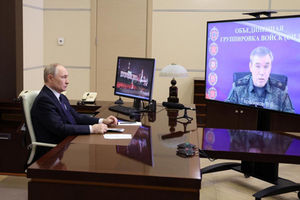Tanzania growth positive as IMF cuts global outlook

Africa faces a double whammy on food -- Russian fertiliser and grain imported from Russia and Ukraine have soared in price.
What you need to know:
- The IMF forecast for Tanzania is slightly slower than the 5.2 percent estimated by the central bank in February 2022.
Dar es Salaam. The International Monetary Fund (IMF) is projecting Tanzania’s economic growth at 4.8 percent this year after cutting the global outlook, amid spreading impact of the Russia-Ukraine conflict.
The IMF forecast for Tanzania is slightly slower than the 5.2 percent estimated by the central bank in February 2022.
It is however within the same range as the one that was projected by the World Bank last month.
The World Bank predicted that Tanzania’s economy will expand between 4.5 percent and 5.5 percent this year, as a rollback of coronavirus-related restrictions in many countries boosts tourism and trade.
IMF now projects the growth at 4.8 percent, taking into account the impact of Russia-Ukraine war which has caused continued uncertainty, supply disruptions and soaring food and fertilizer prices into many African countries.
Tanzania economy, which was estimated to have grown by 4.9 percent in 2021, is recovering from the impact of Covid-19 that disrupted economic activities around the globe.
Tanzania’s tourism sector, which was adversely affected by the Covid-19 pandemic, has been in a recovery mode, with the Bank of Tanzania’s figures showing that during the year ending February 2022, foreign exchange earnings from the sector rose to $1.457 billion from only $645.4 million during a similar period last year.
The rise was due to an 87.9 percent increase in tourist arrivals which reached 958,173 travelers during the year ending February 2022.
On Tuesday, the IMF sharply downgraded its 2022 global growth forecast to 3.6 percent.
That slowdown, 0.8 points lower than its previous estimate released in January, comes amid surging prices, shortages and rising debt levels, the IMF said in its latest World Economic Outlook.
The fallout has been felt most acutely in the poorest nations, threatening to erase recent gains as the world had begun to recover from the Covid-19 pandemic, and the risks and uncertainty remain high, the Washington-based lender warned.
“The economic effects of the war are spreading far and wide -- like seismic waves that emanate from the epicenter of an earthquake,” IMF chief economist Pierre-Olivier Gourinchas said in the report.
Russia invaded Ukraine in late February, devastating the country’s infrastructure and ability to produce grain and other goods, while stiff sanctions on Moscow sent fuel prices higher.
The conflict also sparked a flood of refugees into neighboring countries.
The crisis will be the focus of global finance officials who gather in Washington this week -- virtually and in person -- for the spring meetings of the International Monetary Fund and World Bank.
The report shows Ukraine suffering a 35 percent collapse of its economy this year, while Russia’s GDP will fall 8.5 percent -- more than 11 points below the pre-war expectations.
European nations will see much slower growth as the war drives up fuel and food prices, pushing inflation higher around the world and keeping it high for longer than expected.
The United States and China also will feel the effects of the war and the ongoing impact of the Covid-19 pandemic, with US growth expected to slow to 3.7 percent, and China’s to 4.4 percent.
Surging inflation
The official cautioned that the overall outlook is highly uncertain, and things could get drastically worse if the war is prolonged and tougher sanctions imposed on Moscow.
“Growth could slow significantly more while inflation could turn out higher than expected if, for instance, sanctions aimed at ending the war extend to an even broader volume of Russian energy and other exports,” he said.
Meanwhile, the pandemic is continuing, and lockdowns in China to defeat renewed coronavirus outbreaks are slowing activity, including in manufacturing hubs, which “could cause new bottlenecks in global supply chains.”
The latest crisis hit as the global economy “was on a mending path but had not yet fully recovered from the Covid-19 pandemic,” Gourinchas said.
That has fueled an acceleration of inflation -- expected to hit 5.7 percent in advanced economies this year and 8.7 percent in developing nations -- which endangers the gains of the past two years. And inflation will be elevated for “much longer” than previously expected the report said.
The price pressures have prompted central banks in many countries to begin to raise interest rates to tamp down inflation, but that will hurt highly indebted developing nations, the report noted.
Rising prices were a concern even before the conflict and now shortages caused by the war “will greatly amplify those pressures, notably through increases in the price of energy, metals and food,” Gourinchas said.
The official dismissed comparisons with the wage-price spiral seen in the 1970s, but “nevertheless, inflation is a serious concern right now in the US and in other countries,” he told reporters during a briefing.
Debt distress
That would hit developing nations that have seen debt loads increase with rising interest rates.
Gourinc has added his voice to the call to help countries restructure their debt by improving the G20 Common Framework adopted last year, which was meant to offer a path to restructure large debt loads.
A key hurdle has been the lack of information on the size of debt owed to China, as well as some other lenders, by private companies as well as governments, and the need for private creditors to participate in the debt relief.
It’s in the interest of the borrowing country and the creditors “to have an expeditious process,” he told reporters. “We need a process that works much faster and much better in dealing with situations of insolvencies.”
World Bank President David Malpass, who has been outspoken on the issue, has said 60 percent of low-income countries already face debt distress or are at high risk.




